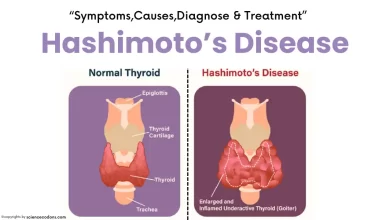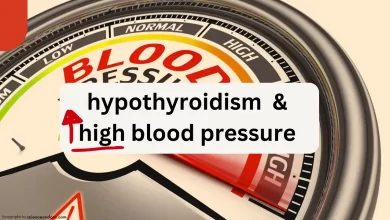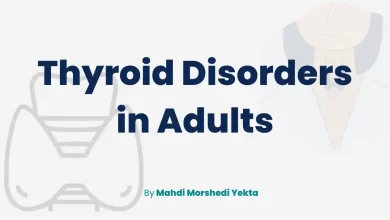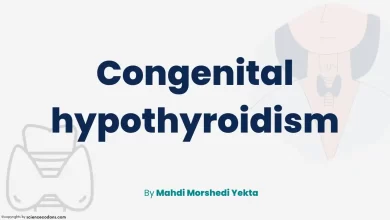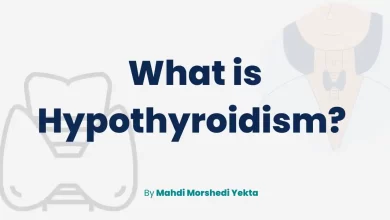Symptoms of thyroid hyperactivity occur primarily due to elevated levels of thyroid hormones in the bloodstream. The disorder causing hyperthyroidism may exhibit specific symptoms.
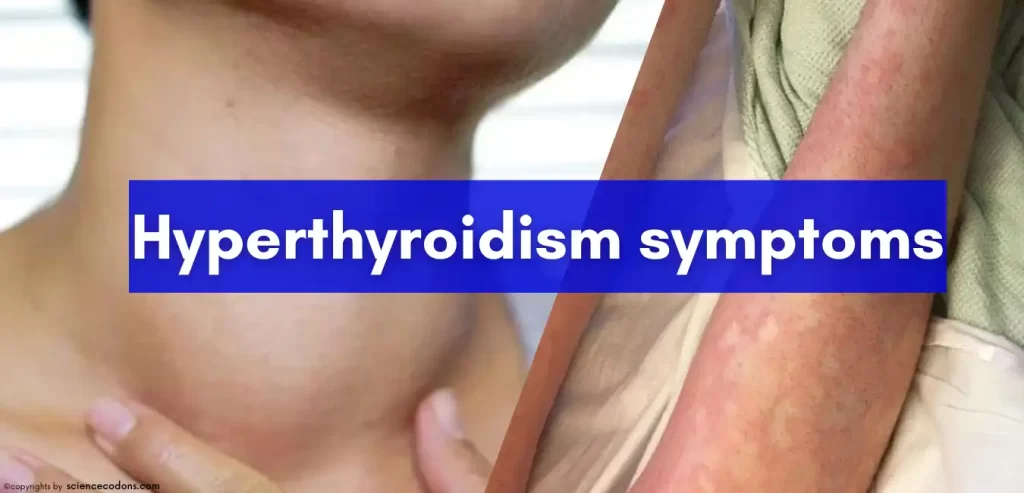
Graves’ disease, the leading cause of hyperthyroidism, can cause specific problems that are not directly linked to elevated levels of thyroid hormones. This article examines the symptoms of thyroid hyperactivity and its impact on various body organs, including the digestive system, skin, hair, nervous system, and other hormones. We will also answer any questions you have about the symptoms of an overactive thyroid.
General Symptoms of hyperthyroidism:
Most individuals with hyperthyroidism experience a range of common and nonspecific symptoms, such as:
- Intolerance to heat can be a problem.
- Tremors
- Rapid Heartbeat
- Anxiety
- Unintentional weight loss despite a normal or increased appetite.
- Increased bowel movements
- Shortness of breath
The thyroid gland enlargement, or goiter (goiter), is often detected during physical examinations. Mild cases of hyperthyroidism and older patients may have subtle symptoms that are difficult to detect.
Specific Symptoms of hyperthyroidism:
In addition to general symptoms, hyperactive thyroid function can affect specific organs and systems, leading to symptoms related to those areas. Since thyroid hormones, specifically T3 and T4, regulate metabolism and impact various bodily systems and organs, excessing these hormones can disrupt normal functioning. We will examine the impact of hyperthyroidism on different organs, including the stomach, digestive system, and skin, among others.
The Effects of Hyperactive Thyroid on the Skin
In cases of hyperthyroidism, the thyroid gland becomes overactive, causing increased blood flow and warm skin. However, it is uncommon for the skin to appear red (erythematous). Additionally, the skin becomes noticeably smoother due to a decrease in the keratin layer.
- Excessive calorie production and heat intolerance can lead to increased sweating.
- Hyperthyroidism can lead to brittle, separating, and softening nails. This condition is referred to as Plummer’s nail.
- In severe cases of hyperthyroidism, where the thyroid is overactive, the accelerated metabolism of cortisol can cause darkening of the skin. This hormonal change can cause hyperpigmentation, which is the darkening of the skin.
- Hyperthyroidism, especially in people with Graves’ disease, can cause itching and the formation of hives on the skin.
- Vitiligo and Alopecia Areata are autoimmune disorders affecting skin and hair. They may also occur concurrently with hyperthyroidism.
- Thinning Hair: Hair thinning is a common symptom of hyperthyroidism.
Dermopathy, a skin condition, is exclusive to individuals with Graves’ disease-induced hyperthyroidism. The condition primarily affects the skin on the shins and appears as raised, dark (hyperpigmented) purple papules resembling an orange peel texture.
Changes in the Eyes Due to Thyroid Hyperactivity
Gaze fixation and lid lag can occur in all patients with hyperthyroidism. These symptoms are believed to be caused by excessive sympathetic activity, which may be linked to increased alpha-adrenergic receptors in the affected tissues.
Lid lag is assessed by evaluating the patient’s ability to track the examiner’s finger as it moves vertically. Lid Lag is indicated when there is a noticeable delay in the downward movement of the eyelid compared to the downward gaze.
Studies have shown that ocular disorders, specifically ophthalmopathy, are only found in patients with Graves’ disease. This condition is characterized by inflammation in the extraocular muscles, orbital fat, and connective tissues, resulting in various manifestations such as eye protrusion (proptosis or exophthalmos), impaired ocular muscle function, and swelling of the tissues around the eye.
- Smoking is a harmful habit that poses serious health risks.
- Advancing Age
- Male Gender
Patients with ocular involvement in Graves’ disease-related hyperthyroidism may experience dryness or discomfort in their eyes. Dysfunction of the extraocular muscles can lead to diplopia or double vision.
Corneal ulceration can occur when the eye protrudes (proptosis), and the eyelid does not close properly. Severe proptosis can lead to optic nerve compromise and vision loss.
Heart Palpitations and Cardiac Symptoms
In hyperthyroidism, the increased tissue metabolism leads to a higher demand for oxygen. Hyperthyroidism can cause an increase in myocardial contractility and heart rate, leading to higher cardiac output. As a result, the heart rate increases, vascular resistance decreases, and tissue perfusion improves. One common symptom experienced by patients with hyperthyroidism is heart palpitations.
In hyperthyroidism, systolic blood pressure tends to increase, and patients may also experience congestive heart failure, specifically heart failure with preserved ejection fraction. Congestive heart failure exacerbates in patients with a previous history of the condition.
As previously mentioned, hyperthyroidism can cause an increase in heart rate, which may lead to irregular heart rhythms and deviations from the normal rhythm. Atrial fibrillation (AF) is a common cardiac arrhythmia that affects 10% to 20% of patients with hyperthyroidism, particularly older individuals.
After treatment, around 60% of patients with hyperthyroidism-induced atrial fibrillation will spontaneously revert to a normal heart rhythm.
Hyperthyroidism can also be linked to other cardiac abnormalities, including mitral valve prolapse (MVP), mitral regurgitation (MR), and left ventricular hypertrophy.
Heart problems, specifically heart palpitations, are a sign of hyperthyroidism, emphasizing the need for thyroid evaluation in these patients.
Bone Problems and Osteoporosis
Thyroid hormones stimulate bone turnover, which can result in increased bone fragility. Osteoporosis is often seen in untreated hyperthyroidism.
Additionally, patients with hyperthyroidism frequently show higher levels of alkaline phosphatase (ALP) and osteocalcin, which suggest increased bone turnover.
Increased bone turnover can lead to elevated serum calcium levels, which can suppress the secretion of parathyroid hormone (PTH) and impede the activation of vitamin D. This can ultimately disrupt calcium absorption and increase calcium excretion in urine.
Graves’ disease can cause thyrotoxicosis and bone resorption, resulting in hand osteopathy. Patients with thyrotoxicosis commonly exhibit symptoms such as unexplained weight loss, severe exophthalmos (bulging eyes), and dermopathy (skin changes). A significant number of these patients are also smokers.
Changes in blood lipids in hyperactive thyroid
In individuals with an overactive thyroid or thyroid hyperactivity, there are usually low levels of total cholesterol and serum HDL. However, these levels typically rise after treatment.
Changes in blood glucose levels
Thyroxine (T4) does not directly regulate blood glucose; an overactive thyroid can disrupt glucose metabolism. Thyroid hormones can increase insulin secretion from the pancreas and decrease the effectiveness of insulin on tissues. Patients frequently experience high blood glucose levels and glucose intolerance. However, these issues can usually be resolved with treatment for hyperactive thyroid.
The Respiratory System and Shortness of Breath
Various factors can cause shortness of breath during physical activity in individuals with thyroid hyperactivity. The increased oxygen consumption and carbon dioxide production in these patients can result in hypoxemia (low oxygen levels) and hypercapnia (high carbon dioxide levels). These conditions can lead to increased ventilation and respiratory rate.
Respiratory muscle weakness is a significant cause of breathlessness in individuals with thyroid hyperactivity, making it challenging for patients to engage in vigorous physical activity.
Rarely, an enlarged thyroid gland (goiter) can compress the trachea, causing difficulty breathing. Thyroid hyperactivity can worsen underlying asthma and raise pulmonary artery pressure, which can make breathing difficulties worse.
The Digestive System and the Stomach
An increase in metabolism primarily causes weight loss in thyroid hyperactivity. Additionally, heightened intestinal motility and increased bowel movements can result in poor nutrient absorption and contribute to weight loss. Some patients may also experience constipation.
Despite an increased appetite in individuals with hyperactive thyroid, weight gain is generally insignificant, particularly in older individuals.
Gastrointestinal problems that can occur with an overactive thyroid include vomiting, abdominal pain, and difficulty swallowing (dysphagia) caused by an enlarged thyroid gland (goiter).
Liver enzyme abnormalities are frequently seen in individuals with thyroid hyperactivity, as indicated by elevated levels of alkaline phosphatase (ALP), alanine aminotransferase (ALT), and aspartate aminotransferase (AST) in blood tests.
Blood Disorders and Red Blood Cells
Thyroid hyperactivity typically increases red blood cell (RBC) mass, although the increase in plasma is greater. Consequently, the hematocrit (HCT) typically decreases, leading to normochromic and normocytic anemia. Elevated blood ferritin levels may indicate thyroid hyperactivity.
Graves’ disease, a common cause of overactive thyroid, may be linked to autoimmune disorders like immune thrombocytopenic purpura (ITP) and pernicious anemia. Some individuals with hyperactive thyroid may also have a low white blood cell count (WBC).
Urinary Disorders
Frequent urination and nocturia (waking up at night to urinate) are common symptoms of thyroid hyperactivity. However, the underlying mechanism for these symptoms is not well understood.
Hyperthyroidism and Sexual Dysfunction in Women
Oligomenorrhea, or infrequent and irregular periods, is a common issue for women with hyperthyroidism. Patients may also experience ovulatory problems and infertility. Therefore, it is recommended to investigate thyroid hormone levels in women with irregular periods and fertility issues.
Menstrual disorders, such as changes in the frequency and intensity of bleeding during each cycle, maybe a sign of hyperthyroidism and should be assessed by a healthcare provider.
Hyperthyroidism and Sexual Dysfunction in Men
In men, the serum concentration of free testosterone is usually within the normal or low range, while the LH (luteinizing hormone) level may be slightly elevated. Additionally, elevated serum estradiol levels can cause gynecomastia (enlargement of breast tissue) in men, as well as reduced libido and erectile dysfunction.
Sperm production(spermatogenesis) is often impaired or abnormal, resulting in an increase in sperm with a strange appearance or reduced ability to move.
Psychological and neurological disorders
Patients with hyperthyroidism may experience behavioral and personality changes, including anxiety and depression. Other less common neurological symptoms in these patients may include:
- Restlessness
- Irritability is a common symptom.
- Emotional instability is a significant factor.
- Insomnia is a sleep disorder characterized by difficulty falling or staying asleep. It can significantly impact a person’s daily functioning and overall well-being.
These behavioral symptoms often occur alongside cognitive impairments, such as difficulties with concentration, confusion, and short-term memory loss.
Summary of Hyperthyroidism Symptoms
The thyroid gland plays a vital role in regulating the body’s metabolism. Any changes in hormone levels can cause a variety of symptoms. Hyperthyroidism is linked to various health issues, including gastrointestinal disorders, skin manifestations, sexual problems, cardiovascular symptoms, respiratory changes, and neurological symptoms. Therefore, any abnormalities in these systems should be evaluated and examined by a medical professional.
| Organ/System | Symptoms |
|---|---|
| General Symptoms | – Intolerance to heat – Tremors – Rapid heartbeat – Anxiety – Unintentional weight loss – Increased bowel movements – Shortness of breath |
| Skin | – Increased sweating – Brittle, separating nails (Plummer’s nail) – Darkening of the skin (hyperpigmentation) – Itching and hives on the skin – Vitiligo and Alopecia Areata – Thinning hair – Dermopathy (specific to Graves’ disease) |
| Eyes | – Gaze fixation – Lid lag – Eye protrusion (proptosis or exophthalmos) – Diplopia (double vision) – Dryness or discomfort in the eyes |
| Heart | – Heart palpitations – Increased heart rate – Atrial fibrillation – Congestive heart failure – Mitral valve prolapse, regurgitation – Left ventricular hypertrophy |
| Bone | – Osteoporosis |
| Blood Lipids | – Low levels of total cholesterol and HDL |
| Blood Glucose | – High blood glucose levels |
| Respiratory System | – Shortness of breath during physical activity – Hypoxemia and hypercapnia |
| Digestive System | – Weight loss – Increased bowel movements – Constipation – Vomiting – Abdominal pain |
| Blood Disorders | – Normochromic and normocytic anemia – Elevated liver enzymes |
| Urinary System | – Frequent urination – Nocturia |
| Sexual Dysfunction | – Oligomenorrhea (irregular periods) – Ovulatory problems and infertility |

